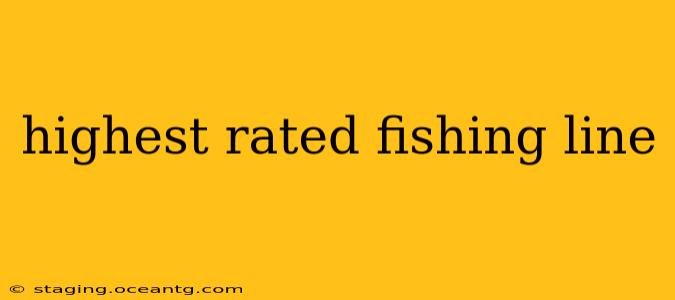Choosing the right fishing line can significantly impact your success on the water. With so many brands and types available, finding the highest-rated fishing line can feel overwhelming. This guide will break down the top contenders, considering factors like strength, durability, sensitivity, and overall performance to help you make an informed decision. We'll also tackle some frequently asked questions to further clarify your selection process.
What Makes a Fishing Line "High-Rated"?
Before diving into specific brands, let's define what constitutes a high-rated fishing line. Several key factors contribute to a line's overall rating:
- Strength: The line's ability to withstand pressure without breaking is crucial, especially when battling larger fish. Higher tensile strength means a more reliable line.
- Durability: A durable line resists abrasion, UV degradation, and general wear and tear, extending its lifespan and providing consistent performance.
- Sensitivity: A sensitive line transmits subtle bites and movements from the fish to your rod, allowing for earlier hooksets and increased success.
- Castability: A line that casts smoothly and accurately is essential for reaching distant targets and presenting your bait effectively.
- Knot Strength: The ability of the line to hold knots securely is vital. A weak knot can lead to lost fish and frustrating experiences.
- Visibility/Invisibility: Depending on the fishing situation, you might prefer a highly visible line or a nearly invisible one for stealthier approaches.
Top Contenders for Highest-Rated Fishing Line: A Brand Overview (Note: Specific ratings vary across different review platforms and user experiences.)
While pinpointing the single "highest-rated" line is subjective and dependent on individual needs and fishing styles, several consistently receive top marks:
- Fluorocarbon Lines: Known for their low visibility underwater, high abrasion resistance, and excellent strength-to-diameter ratio. Brands like Seaguar and Sunline are frequently praised for their quality fluorocarbon lines.
- Braided Lines: Extremely strong and thin, offering excellent sensitivity and long casting distances. Popular brands include PowerPro, Sufix, and Spiderwire. Braids are often used as the main line or for leader applications.
- Monofilament Lines: A classic choice, offering a good balance of strength, stretch, and affordability. Brands like Berkley Trilene and P-Line remain popular choices due to their reliability and widespread availability.
It's important to note that within each category, specific line types (e.g., high-visibility, low-stretch, etc.) will cater to different fishing techniques and environments.
H2: What type of fishing line is best for beginners?
Beginners often find monofilament lines the easiest to work with. Their inherent stretch helps absorb shock during the fight with a fish, making it easier to manage the hookset and landing process. The added forgiveness of monofilament allows beginners to focus on learning casting techniques and understanding fish behavior without the added complication of a more technical line type.
H2: How do I choose the right fishing line test?
The line test (or pound test) indicates the line's breaking strength. Selecting the appropriate test depends on the type of fish you're targeting, the size of your rod, and the fishing conditions. Larger fish require heavier line tests, while smaller fish can be effectively targeted with lighter lines. Always consult your rod's recommendations for an appropriate line weight range.
H2: How often should I replace my fishing line?
Line deterioration occurs gradually due to exposure to UV light, abrasion, and general wear and tear. It's good practice to inspect your line regularly for nicks, abrasions, or any signs of weakening. Replacing your line at least once a year or more frequently if needed is a good preventative measure.
H2: What are the differences between monofilament, fluorocarbon, and braided lines?
- Monofilament: Offers good strength, stretch, and affordability. It's visible in the water and relatively easy to use.
- Fluorocarbon: Nearly invisible underwater, offers high abrasion resistance, and excellent strength-to-diameter ratio. It's more expensive than monofilament.
- Braided: Extremely strong, thin, and sensitive. It casts well but can be more difficult to knot than monofilament or fluorocarbon. It offers very little stretch.
Conclusion: Finding Your Perfect Match
The "highest-rated" fishing line is ultimately a matter of personal preference and fishing style. By understanding the key characteristics of different line types and considering your specific needs, you can confidently choose a line that will elevate your fishing experience and significantly increase your chances of success. Remember to always consider the type of fish you are targeting, the fishing conditions, and your personal preferences when making your choice. Experimentation is key to finding the perfect match!
